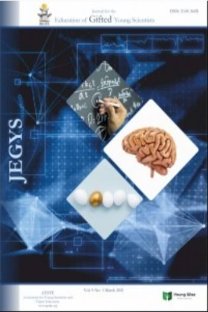The Role of Technology in Science Teaching Activities: Web Based Teaching Applications
In this research the attitudes of pre-service teachers studying at Hacettepe University, Division of Science Education towards the importance of technological equipment in chemistry education activities and how effective they find technology in teaching different skills and applications have been examined. Pre-test/post-test control group design has been used in the research. In the experimental group Titrimetric Analysis has been conducted with simulations supported web based instruction and in the control group with teacher-centered instruction. In general, it has been found out that the attitudes of pre-service teachers in experiment group towards the importance of technological equipment as a teaching tool in chemistry are more positive than those in control group. In other words, statistically significant differences have occurred in attitudes of pre-service teachers in both experiment and control group towards the role of technology in chemistry teaching activities after web based teaching.
Keywords:
usage of technology in teacher education web based chemistry teaching, pre-service teachers,
___
- Alkan, F., & Koçak, C. (2015). Chemistry laboratory applications supported with simulation. Procedia-Social and Behavioral Sciences, 176, 970-976.
- Bransford, J., Brown, A., & Cocking, R. (2000). How people learn: Brain, mind, and experience & school. National Academy Press.
- Collins, M. (1998). The use of email and electronic bulletin boards in college-level biology. Journal of Computers in Mathematics and Science Teaching, 17 (1), 75-94.
- Crawford, B.A., & Cullin, M.J. (2004). Supporting prospective teachers’ conceptions of modeling in science. International Journal of Science Education, 26, 1379–1401.
- Çepni, S. (2005). Science and technology education. Ankara: Pegem A Press.
- Çetin O., Çalışkan E., & Menzi, N. (2012). The relationship between technological competencies and attitudes of pre-service teachers towards technology. Elementary Education Online, 11(2), 273-291.
- Çil, H. (2008). The role of technology in educational activities: The views of teachers. Unpublished Master’s Thesis, Zonguldak Karaelmas University, Institute of Social Sciences, Zonguldak.
- Erdoğan, Y., Bayram, S., & Deniz, L. (2007). Web based instruction attitude scale: Explanatory and confirmatory factor analyses. International Journal of Human, 4(2), ISSN: 1303-5134.
- Ferdig, R.E. (2006). Assessing technologies for teaching and learning: understanding the importance of technological pedagogical content knowledge. British Journal of Educational Technology, 37(5), 749–760.
- Fraenkel, J.R., & Wallen, N.E. (2009). How to Design and Evaluate Research in Education (7th ed.).Boston: McGraw-Hill.
- Frith, K.H., & Kee, C. (2003). The effect of communication on nursing student outcomes in a web-based course. Journal of Nursing Education, 42 (8), 350-358.
- Glenn, A. (2001). A comparison of distance learning and traditional learning environments. Unpublished Doctoral Thesis, Faculty of the Graduate School of Texas A&M University, Texas.
- Green, S.B. & Salkind, N.J. (2008). Using SPSS for Windows and Macintosh (5th edition). Prentice Hall.
- Harwood, W.S., & McMahon, M.M., (1997). Effects of integrated video media on student achievement and attitudes in high school chemistry. Journal of Research in Science Teaching, 34(6), 17-31.
- Horton, W. (2000). Designing web-based training. Wiley Computer Publishing, John Wiley & Sons, USA.
- Kozma, R.B., & Russell, J. (1997). Multimedia and understanding: Expert and novice responses to different representations of chemical phenomena. Journal of Research in Science Teaching, 34, 949–958.
- Kurubacak, G. (2000). Online learning: A study of student’s attitudes towards web-based instruction. Unpublished Doctoral Thesis, University of Cincinnati, OH.
- Li, Y., & Perkins, A. (2007). The impact of technological developments on the daily life of elderly. Technology in Society, 29, 361–368.
- Urhahne, D., Nick, S., & Schanze, S. (2009). The effect of three-dimensional simulations on the understanding of chemical structures and their properties. Research in Science Education, 39, 495–513.
- Waight, N., Liu, X., Gregorius, R. M., Smith, E., & Park, M. (2014). Teacher conceptions and approaches associated with an immersive instructional implementation of computer-based models and assessment in a secondary chemistry classroom. International Journal of Science Education, 36(3), 467–505, DOI: 10.1080/09500693.2013.787506.
- Van Wyk, G., & Louw, A. (2008). Technology-assisted reading for improving reading skills for young South African learners. The Electronic Journal of e-Learning, 6 (3), 245-254.
- Başlangıç: 2013
- Yayıncı: Genç Bilge Yayıncılık
Sayıdaki Diğer Makaleler
Ahmet YUMUŞAK, İsmail MARAŞ, Mehmet ŞAHİN
Sonja ČOTAR KONRAD, Mojca KUKANJA GABRIJELČIČ
